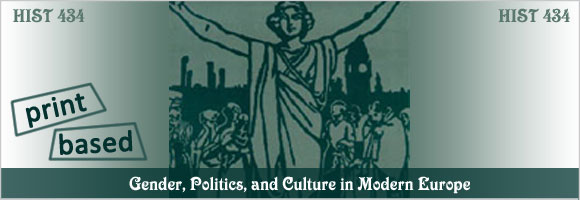
Mode of Delivery
This is a print-based, correspondence course.
Course Outline
- Nine assignments
- Final examination
Course Description
HIST 434: Gender, Politics, and Culture in Modern Europe examines the relationships between changing gender roles and other historical processes in Europe from the eighteenth century to the present. Through an exploration of selected topics—from the French and industrial revolutions to imperialism, nationalism, and the rise of consumer cultures—you will be introduced to historiographical developments and theoretical debates in women’s history and the history of gender.We will be considering a variety of themes, including (but not limited to) the significance of gender in family life, work, politics, and sexuality. Attention will be paid to the history of masculinity as well as femininity, and to the ways in which other historical relationships—such as those of class and race—complicate our understanding of this topic.
Intended Audience
History 434 is designed to introduce you to what is still a relatively new and controversial perspective on European history. Although it may be helpful if you have some background in European history or history more generally, this course is also open to anyone looking for an introduction to historical method or to European history. There are no prerequisites for the course.
Course Objectives
Upon completion of History 434 you will:
- be able to formulate for yourself a working definition of “gender” as a category of analysis, and your own evaluation of its usefulness. You should be able to apply this not only to the history of modern Europe but to other contexts as well.
- be able to trace the historical roots of many of the issues that continue to trouble our own society: you will have started thinking about the very long histories of such modern questions as women’s rights and women’s work, reproductive rights, and the campaign for “family values.”
- have a basic understanding of the central events in modern European history, of their impact on both women and men, and of the way that gender interacts with other structures of power, such as race, class, and sexuality.
- have refined the skills of reading, writing, and critical analysis of both primary and secondary sources.
- be comfortable with the use of primary sources, and have had an opportunity to be a historian as well as a history student. You will have had some experience with the difficulties involved in selecting and using evidence to analyze and interpret the past, and will have begun to draw your own conclusions on the basis of which you may revise or reject the work of other historians.
- recognize the key debates and controversies in the fields of gender studies and women’s history, and have a sense of where you stand in these debates.
Course Overview
The course is divided into an introduction and conclusion and four larger units. The first three units will cover the late eighteenth and nineteenth centuries, while the last one will deal primarily with twentieth century issues. Units I and II examine two of the foundational events of the modern period in European history: the French Revolution and the Industrial Revolution. Unit III explores the impact of science—which came to challenge religion as a form of cultural authority during this period—on gender relations and sexuality. The last unit of the course begins by exploring the relationships between gender, the nation, and imperialism in the late nineteenth and early twentieth centuries. We then examine the transformation of gender relations by the growth of the state in a variety of contexts.
Course Work
History 434 contains the following graded course work:
- five brief discussions (mini-papers),
- three medium papers
- one major paper, and
- a final examination.
Evaluation
| Five Mini Papers (4% each) | 20% |
| Three Medium Papers (10%, 10%, 15%) | 35% |
| One Major Paper | 20% |
| Final Examination | 25% |
|
Total
|
100% |
In order to pass the course you must pass the final examination.
Textbooks and Course Materials
The following are required texts for History 434:
- Smith, Bonnie G. Changing Lives: Women in European History Since 1700. Toronto: D. C. Heath and Co., 1989.
- Quine, Maria Sophia. Population Politics in Twentieth-Century Europe: Fascist Dictatorships and Liberal Democracies. Routledge, 1996.
- Custom Course Materials for HIST 434 (includes course handouts).
- Alexander, J.W., and J. Dixon. Thomson Nelson Guide to Writing in History. 1st Can. ed. Thomson Nelson, 2006.
plus one from the following list:
- Desan, Suzanne. The Family on Trial in the French Revolution. University of California Press, 2006.
- Holmes, Rachel. African Queen: The Real Life of the Hottentot Venus. Random House, 2007.
- Kuchta, David. The Three-Piece Suit and Modern Masculinity: England 1550-1850. University of California UP, 2002.
- Marcus, Sharon. Between Women: Friendship, Desire and Marriage in Victorian Britain. Princeton UP, 2007.
- Mani, Lata. Contentious Traditions: The Debate on Sati in Colonial India. University of California UP, 1998.
- Valenze, Deborah. The First Industrial Woman. Oxford UP, 1995.
- Wilson, Kathleen. The Island Race: Englishness, Empire and Gender in the Eighteenth Century. Routledge, 2002.
Also required is:
- HIST 434 Learner Package – which includes the course manual.
